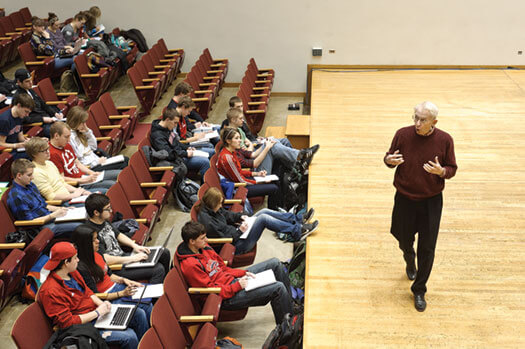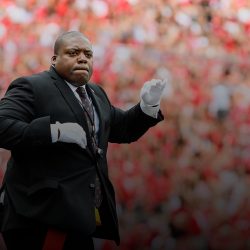Music 660: The Legendary Performers

Michael Leckrone gets students to develop an appreciation for legendary musicians and singers who are not necessarily found on their iPod playlists, such as Billie Holiday, Bessie Smith, and Fats Waller. Photo: Bryce Richter.
Today’s successful artists are influenced by the greats of past eras.
Learning from a campus legend
Marching Band director Michael Leckrone has been teaching this popular class for non-music majors for more than twenty years. That sounds like a long time, but he has been at the university for forty-four years.
What’s that sound?
Students show up wearing earbuds and listening to whatever is in rotation on their iPods, but when they enter the Mills Concert Hall inside the George L. Mosse Humanities Building, they take a musical step back to another sonic era. “Most of [the music] they’ve never experienced before, but have maybe had brushes with it on TV, or in movies or commercials,” Leckrone says. His students like the way Leckrone involves the class, asking them to describe what they hear, whether they like it, and why it is or isn’t music to their ears. “He teaches you a different way of listening to music,” says Dan Muth ’13, a senior majoring in industrial engineering.
Defining legend
Leckrone focuses on artists from 1920 to 1950 who captured the musical magic of that time, yet also influence today’s artists. The first lecture explores blues singer Bessie Smith. “Bessie led us to Janice Joplin; Bing [Crosby] led us to Michael Bublé; [Al] Jolson led us to Michael Jackson,” he says. “Louis [Armstrong] led, and everyone followed!” The era also featured Nat King Cole, Judy Garland, Billie Holiday, Jelly Roll Morton, and Fats Waller.
Spotlight on history
While there’s a lot of good music and a lot of good musicians, not all rise to the category of legendary performer, Leckrone says. “They had to have established a new style or done something socially that was a huge step forward,” he says. “I’m very interested in what has happened historically.” Take Jolson, a performer many students aren’t familiar with until Leckrone shows them clips from The Jazz Singer. The film is in black and white, and the sound isn’t perfect. But it captures a time when Jolson ruled the music scene, singing “Blue Skies” and “My Mammy.” The students learn that Jolson’s performances abroad during World War II helped lead to the formation of the United Services Organization.
New appreciation
Leckrone doesn’t expect to convert all of his students into huge fans of Jolson or others. Rather, he wants to help them develop an appreciation of what came before today’s tunes. “I knew nothing,” says Amy Pedersen x’14, a biology major. “After listening to some of this music, you realize it laid the foundation for a lot of the modern music you hear.” So while Pedersen is still more a fan of Jack Johnson, she has a newfound appreciation for Jolson. “It’s actual music — not like a lot of the electronic stuff you hear. … It’s not perfect — it’s raw.”
Coda
After class, the earbuds and iPods reappear. Leckrone gets it: this music won’t necessarily become part of their everyday music rotation — and that’s okay with him. “What I want to do is help them become more discriminating listeners,” he says. “Hopefully, I get them to open their minds to more music. We hear music all the time, but sometimes you don’t take time to open up your ears and really listen to it.”
Published in the Summer 2013 issue



Comments
No comments posted yet.